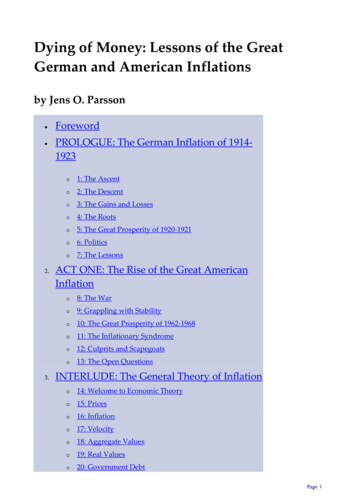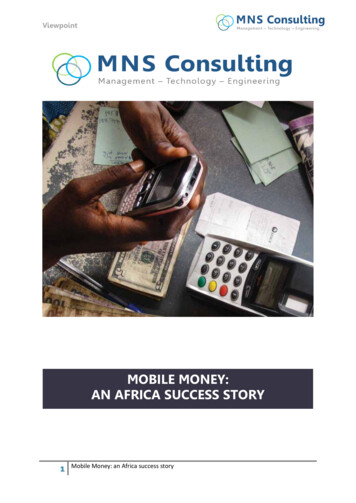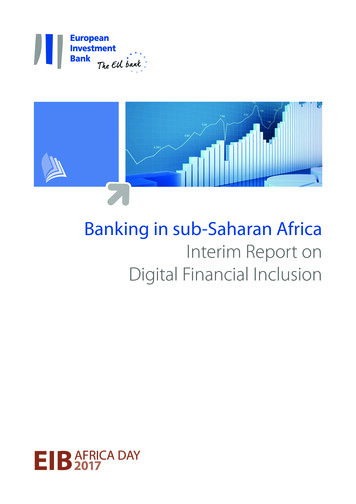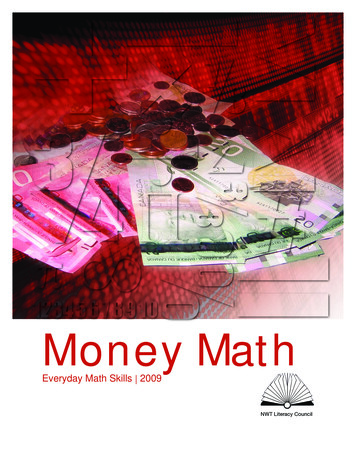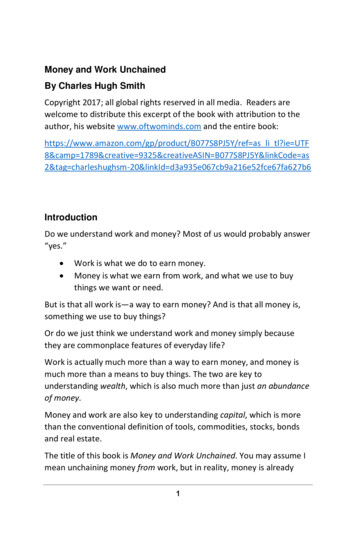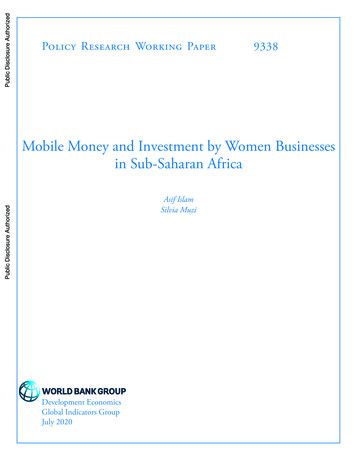
Transcription
Public Disclosure Authorized9338Mobile Money and Investment by Women Businessesin Sub-Saharan AfricaAsif IslamSilvia MuziPublic Disclosure AuthorizedPublic Disclosure AuthorizedPublic Disclosure AuthorizedPolicy Research Working PaperDevelopment EconomicsGlobal Indicators GroupJuly 2020
Policy Research Working Paper 9338AbstractThis study connects two important findings in Sub-SaharanAfrica. First, digital technologies such as mobile moneyhave become widespread and have increased investment bybusinesses, especially in East Africa. Second, women-ownedbusiness in the region significantly lag their male counterparts in capital investments. Using data for 16 Sub-SaharanAfrican economies, the study connects the two findings byexploring whether mobile money use by women-ownedfirms increases their investment. The findings indicate thatthe positive relationship between mobile money use andinvestment is largely driven by women-owned firms andis statistically insignificant for men-owned firms. Potential channels of these effects are explored. Women-ownedfirms that use mobile money to transact with suppliers aremore likely to invest. Mobile money also seems to facilitategreater provision of customer credit and generally greaterdemand for more credit by women-owned firms. Such patterns are not observed for men-owned firms.This paper is a product of the Global Indicators Group, Development Economics. It is part of a larger effort by the WorldBank to provide open access to its research and make a contribution to development policy discussions around the world.Policy Research Working Papers are also posted on the Web at http://www.worldbank.org/prwp. The authors may becontacted at aislam@worldbank.org.The Policy Research Working Paper Series disseminates the findings of work in progress to encourage the exchange of ideas about developmentissues. An objective of the series is to get the findings out quickly, even if the presentations are less than fully polished. The papers carry thenames of the authors and should be cited accordingly. The findings, interpretations, and conclusions expressed in this paper are entirely thoseof the authors. They do not necessarily represent the views of the International Bank for Reconstruction and Development/World Bank andits affiliated organizations, or those of the Executive Directors of the World Bank or the governments they represent.Produced by the Research Support Team
Mobile Money and Investment by Women Businessesin Sub-Saharan AfricaAsif Islam 1 and Silvia Muzi 2JEL: J16, E22, G2, L25, O16Keywords: gender, mobile money, financial development, investment, firms, Africa12Office of the MENA Chief Economist, MNACE, World Bank, Washington DC. Email: aislam@worldbank.orgEnterprise Analysis Unit, DECIG, World Bank, Washington DC. Email: smuzi@worldbank.org
1. IntroductionDigital technologies can provide opportunities for developing economies to leapfrog into thefuture. They can change the nature of businesses, create better employment opportunities, andpotentially transform lives (World Bank, 2019a). Internet upgrades have been found to increaseemployment into higher skilled occupations in Africa (Hjort and Poulsen, 2019), showing thepotentially inclusive nature of such technologies. 3 Mobile money is a digital technology successstory that, originally adopted mainly in East Africa, then spread to the rest of the continent andbeyond. Mobile money penetration has been well-documented, with studies showing severalbenefits for individuals and households (Aker and Mbiti, 2010; Suri and Jack, 2016) throughreduction of transaction costs (Jack and Suri, 2014), lowering of travel costs (Aker et al. 2013;Bångens and Björn Söderberg 2011), increases in welfare by smoothing unexpected income shocks(Jack and Suri 2014), increasing security (Wright et al. 2014), and facilitating remittances(Munyegera and Matsumoto 2016).Given the potentially inclusive effects of digital technology, a key question is whether mobilemoney adoption and diffusion has benefited women, particularly in Africa where gender disparitiesare still notable. Young women in Africa are less likely to be employed than young men due tochallenges in obtaining skills, distorted time allocation, and limited access to capital (World Bank,2020). Evidence at the household and individual levels indicates that mobile money may havehelped women. In Niger, cash transfers through a mobile money system in response to a droughtled households to diversify the crops grown, especially for women who in response grew cashcrops (Aker et al., 2013). In Kenya, mobile money alleviated poverty, particularly for femaleheaded households where women moved out of subsistence farming and changed their mainoccupation to business or retail (Suri and Jack, 2016).Persistent gender disparities are observed also for women entrepreneurs. Female-ownedbusinesses in Africa tend to have fewer employees, lower value-added, and lower productivitythan their male counterparts (World Bank, 2019b). Part of the observed productivity gaps can beattributed to outward orientation (export status and foreign ownership), the ability to protect3See similar findings between internet and female labor force participation in Jordan (Viollaz and Winkler, 2020).2
themselves from crime, and also the use of digital technology (Islam et al., 2020). Anothersignificant disparity between female-owned and male-owned businesses is the degree of capitalinvestment. Data from 14 impact evaluations show that the average capital investment by femaleowned firms is more than six times lower than the average for male-owned firm in Africa (WorldBank, 2019b). A key question to answer is, therefore, whether highly inclusive digital technology,like mobile money, can benefit women enterprises by increasing their investments.A recent study across four East Africa economies uncovered a positive relationship betweenmobile money use and investment by firms (Islam et al, 2018). This study revisits this relationshipby exploring whether this relationship varies by gender of the business owner, and also extendingthe sample of study from 4 economies in East Africa to 16 economies across Sub-Saharan Africa.The analysis is based on a unique firm-level data set with a mobile money module that isimplemented using a consistent methodology and the same survey instrument for about 4,700formal firms across 16 countries in Sub-Saharan Africa. The findings are striking. The positiverelationship between mobile money use and investment is confirmed; more importantly, therelationship is largely driven by female-owned firms and is statistically insignificant for maleowned firms. The identification strategy employed is unlikely to obviate all concerns ofsimultaneity bias between mobile money use and investment given the cross-sectional nature ofthe data. However, the fact that the relationship is uncovered for female-owned but not maleowned firms attenuates some of the concerns of reverse causality. Furthermore, this study providesexternal validation for experimental evidence that shows mobile money savings leading to greatercapital investments by female-owned micro-business in Tanzania (Bastian et al., 2018) andsmallholder farmers in Mozambique (Batista and Vincente, 2020).We explore potential channels that may convey this effect. Female-owned firms that use mobilemoney to transact with suppliers are more likely to invest. The importance of supplier relationshipsuncovered by this paper is consistent with the results of Beck et al. (2018) that find that access totrade credit generates demand for using mobile money as a payment method with suppliers.However, we do not find any significant relationship between mobile money use and suppliercredit. Only payments to suppliers specifically undertaken through mobile money have a positiveeffect on investment by female-owned firms. We also find that female-owned firms that use mobile3
money are likely to offer more credit to customers and also demand more credit, while maleowned-firms do not. One potential explanation is that mobile money builds trust between womenowned businesses and suppliers and customers, providing opportunities to expand and invest.Alternatively, mobile money may provide liquidity to female-owned firms, allowing them to lendto customers. The provision of customer credit is more under the control of businesses thansupplier credit, which is ultimately a decision by the supplying firm. Gosavi (2018) uncovered apositive relationship between mobile money and access to credit for a smaller sample of economiesin East Africa.This study builds on the emerging literature exploring mobile money adoption by businesses, andits benefits. This literature has typically focused on a single or a handful of economies, mainly inEast Africa. Gosavi (2015) investigates the characteristics of businesses that use mobile money inKenya, Tanzania, Uganda, and Zambia and explores the relationship between mobile money andaccess to finance for the same sample (Gosavi, 2018). A precursor to this study, Islam et al, (2018)find a positive relationship between mobile and investment for firms in Kenya, Uganda, andTanzania. Beck et al (2018) model the relationship between the adoption of mobile money,entrepreneurial growth, and finance, calibrating their model to match firm-level data from Kenya.Bastian et al. (2018) experimentally explore the relationship between mobile money savings andthe growth of female-owned micro-businesses in Tanzania and Indonesia. This study is the first toexhaustively explore the relationship between mobile money and investment for formal firms in16 economies across Sub-Saharan Africa. It also provides important descriptive information forpolicy makers on adoption rates and the reasons for mobile money use by firms across Sub-SaharanAfrica.This study also relates to the literature on access to finance for women entrepreneurs, a topic ofgreat interest given that financing obstacles hold back firms (Beck et al., 2005 and Ayyagari et al.,2008) and that discrimination in access to finance limits growth of women-led businesses andrepresents an obstacle for their investing opportunities (World Bank, 2011). The growing body ofliterature on this topic has focused mainly on gender-based discrimination in credit rationing anddiscouraged borrowers. Evidence is mixed as to whether female-owned firms are more financiallyconstrained than male-owned firms in Sub-Saharan Africa (Asiedu et al., 2013; Aterido et al.,4
2013; Hansen and Rand, 2014a; Hansen and Rand, 2014b). This study, in line with Beck et al.(2018), moves beyond the traditional focus on credit access, showing the importance of improvingmore broadly access to financial services, including payment services, as tool to stimulate businessperformance.To summarize, the study contributes to the literature in the following ways. First, it uses nationallyrepresentative firm-level data for 16 economies across Sub-Saharan Africa, making it one of themost exhaustive studies in the region providing new information on mobile money penetration atthe firm level. Second, it affirms the finding that mobile money increases investments by firmsthat was initially found for four economies in the region mostly in East Africa and finds that therelationship between mobile money use and investment by firms in Sub-Saharan Africa is largelydriven by female-owned businesses. Finally, it uncovers suggestive evidence that supplier andcustomer relationships and the demand for credit may be the mechanisms through which mobilemoney leads female-owned firms to invest but not male-owned firms.The rest of the study is structured as follows. Section 2 provides the conceptual framework; section3 provides data details, summary statistics, and mobile money adoption patterns in the region;section 4 details the empirical strategy; section 5 provides the results; section 6 explores severalmechanisms; section 7 provides robustness checks and section 8 concludes.2. Related Literature and Conceptual FrameworkThe relationship between transaction costs, access to credit and investment has been wellestablished. In the neoclassical model, the accelerator model, and the Q theory of investment, theoptimal level of investment is achieved with zero transaction costs and no budget restrictions; asper the Modigliani-Miller theorem (Modigliani and Miller, 1958), perfect capital markets carry theimplication that the firm’s financial structure has no role in investment decisions. Subsequentliterature has challenged the assumption of perfect capital markets with asymmetric informationleading to credit rationing (Stiglitz and Weiss, 1981) and has thus made the availability of capital5
the main determinant of investment (Greenwald et al., 1984); and transaction costs may makeexternal sources of finance prohibitively costly, forcing firms to rely on internal funds.With regards to mobile money, Jack and Suri (2014) model the effect of reducing transaction costson consumption smoothing risk sharing arrangements among mobile money users. Every transferof resources across individuals incurs some transaction cost. As transaction costs decline with themobile money, more exchanges across individuals become feasible, therefore increasing theoptions for consumption smoothing.Falling transaction costs increase the number of transactions and expand networks. Similarly,mobile money may alleviate enforcement costs of firms’ transactions: time and distance forservices rendered can be instantaneous; low-cost and consistent record keeping of transactions canincrease trust and nurture better terms and conditions as business transactions are repeated, therebypotentially increasing the volume of operations; and lower outstanding liquidity balances arerequired for the same level of business activity. With poor infrastructure and under-developedbanking sectors, accessing banks in developing economies may involve time consuming travelcosts as well as waiting in line time costs. Mobile money use has been found to circumvent suchtransaction costs especially in Africa (Aker et al., 2013; Jack and Suri, 2014). The reduction ofsuch costs and the ease of money transfer via mobile money improves the liquidity of the firm ascash flows through the firm at a faster rate (Bangens and Soderberg, 2011). The consequent freedup resources can be used to potentially increase investment levels. There is an established literaturethat has identified the positive effect of improved cash flows on investment (Kadapakkam et al.,1998). Islam et al (2018) have empirically shown a link between mobile money use andinvestments by firms in East Africa.The effects of mobile money on investment may differ by personal characteristics such as thegender of the business owner. This is because mobile money may be helpful to circumventdiscrimination in access to capital. Taste-based discrimination (Becker, 1957) and statisticaldiscrimination (Phelps, 1972; Arrow, 1973) may both affect financial markets (Aterido et al.,2013). Based on Becker’s taste-based discrimination theory, a male dominated financial systemmay imply higher barriers to accessing financial services for women than men. While, based onthe Arrow and Phelps statistical discrimination theory, where discrimination is based on rational6
optimizing behavior and limited information, information asymmetry problems could have greatereffect among female-owned firms due to lack of credit history or limited access to collateral.The magnitude of such effects will depend on how the key theoretical channels between mobilemoney and investment may be affected by gender. Mobile money use may improve supplier andcustomer relationships and increase demand for credit. Beck et al. (2018), using a dynamic generalequilibrium model with heterogeneous entrepreneurs, imperfect credit markets, and the risk oftheft, find a positive relationship between supplier credit and mobile money use. Empirically theliterature has documented the role of trade credit, via reputation effects, in increasing access toexternal sources of financing such as bank financing (Alphonse et al., 2006; Buckart and Ellingsen,2004). Women entrepreneurs may have difficulty accessing suppliers and customers or breakinginto networks dominated by men due to women-specific barriers in mobility or access to resources.If mobile money provides women greater access to supplier and customer networks, then this couldlead to more opportunities to expand and invest. In other words, mobile money would providewomen access to networks that men already have access to. Thus, the use of mobile money maylead to increased investment for female-owned businesses but not necessarily for male-ownedbusinesses.There is considerable debate whether female-owned businesses face more barriers in accessingfinance than male-owned business. Asiedu et al. (2013) find that female-owned firms in SubSaharan Africa have difficulty accessing finance, while Hansen and Rand (2014a) do not findgender-specific differences in access to finance. The empirical link between access to finance andinvestment has been well established (Rajan and Zingales, 1998; Levine et al., 2000; DemirgucKunt and Maksimovic, 1998; Cull and Xu, 2005). If we assume that access to finance is harder forwomen entrepreneurs than male entrepreneurs, then mobile money may provide female-ownedbusinesses access to financing that was already available to male entrepreneurs. Therefore, throughthe financing channel we can expect mobile money to have a positive effect on investment byfemale-owned businesses but not male-owned businesses. Similarly, the collection of transaction,savings, and financial operations data from digital financial service platforms may generate creditscores and evaluate and price credit risk. This can help to overcome the so-called collateraltechnology hurdle, which has hindered the development of credit markets in Africa (Ndung’u,Morales, and Ndirangu. 2016). Mobile money can provide female-owned firms a way to develop7
records and thereby access financing that male-owned businesses may already access. This studyaims to empirically test the key hypothesis of whether the relationship between mobile money useand investment varies by the gender of the business owner.3. Data and Summary StatisticsThe main data source used in this paper consists of cross-sectional firm-level surveys for 16economies across Sub-Saharan Africa conducted by the World Bank’s Enterprise Surveys (ES).Table A2 presents the list of economies. Most of the surveys were conducted between 2015 and2017 apart from four economies (Ghana, Tanzania, Uganda, and Zambia) for which data werecollected in 2012. The ES collect information on a representative sample of formal (registered)private firms with at least five employees operating in manufacturing or services sectors. The ESdata are fully comparable across countries and are collected via face-to-face interviews withbusiness owners or top managers by using a global methodology. 4 The data have been widely usedby several studies to explore the private sector in developing economies (Paunov, 2016; Besleyand Mueller, 2018; Chauvet and Ehrhar, 2018; Hjort and Poulsen, 2019; Falciola et al., 2020).The ES global methodology includes a consistent definition of the universe of inference, astandardized survey instrument, a uniform methodology of implementation, and a standardsampling methodology. The selection of firms in each country is done by stratified randomsampling with three levels of stratification: sector of activity, firm size, and location within thecountry. Sampling weights are used to correct for unequal probability of selection as well as forineligibility and non-response. 5 Supervisors and enumerators attend formal training sessions toensure the best practices are deployed. Several quality control checks are implemented toguarantee the quality of the data throughout the data collection process. Consistency checks areemployed for 10 percent and 50 percent batches of the data during the survey so as to allow quickcallbacks to respondents to be undertaken when necessary to verify information.Several aspects of the business environment are measured by the ES: infrastructure, regulations,taxes, finance, corruption, crime, informality, and competition. In addition, firms’ characteristicsES data are collected using Computer Assisted Personal Interviewing (CAPI) software.More information on the Enterprise Surveys global methodology as well as on the sample design and weightscomputation for the 16 economies is available on the website http://www.enterprisesurveys.org.458
and firms’ outcomes are also covered, including firms’ age, legal status, international markets’engagement, workforce composition, gender, innovation, and performance. The gender sectionincludes information on whether the firm has a female owner. The 16 ES conducted in Sub-SaharanAfrica included a section on mobile money adoption and use. To the extent of our knowledge thisis the most extensive firm-level data on mobile money adoption in Sub-Saharan Africa. Summarystatistics for the sample are provided in table 1.3.1 Mobile Money AdoptionTable 1 shows that 27 percent of firms in the sample have adopted mobile money. About 15 percentof firms used mobile money to receive payments from customers, which is the most common useof mobile money by firms in the sample. This is followed by paying utility bills (10 percent),paying suppliers (8 percent) and finally paying employees (4 percent). Table A1 provides thebreakdown by whether or not the firm has at least one woman among the owners (female-ownedfirms). About 29 percent of female-owned firms and 26 percent of fully male-owned firms usemobile money for financial transactions. The difference is not statistically significant. With regardsthe use of mobile money, 76 percent of female-owned firms use mobile money to receive paymentsfrom customers in contrast to 60 percent of fully male-owned firms. The difference is statisticallysignificant at the 5 percent level. The other uses of mobile money do not show any statisticallysignificant difference between female and male-owned firms.There is considerable heterogeneity in the adoption of mobile money by firms across economies.Kenya (2017) had the highest penetration with 77 percent of firms using mobile money (TableA2). This is followed by Zimbabwe in 2015 (68 percent) and Uganda in 2012 (54 percent). At theother end, Guinea (6.7 percent) in 2015, and Ghana (4.2 percent) and Zambia (3.7 percent) in 2012have the lowest rates of mobile money penetration. The time differences in the surveys couldexplain some of the penetration rates given that penetration may be higher for more recent yearsdue to technological or regulatory advancements. This is empirically accounted for in theestimations.In table 2 we regress mobile money use on a number of firm-level variables, accounting forlocation (within country) and sector fixed effects. We explore these correlations by female-owned9
versus male-owned firms as well. Firms that have a checking or savings account, faced more bribesolicitations and experienced losses due to crime are more likely to adopt mobile money. Thesecorrelations are in line with previous findings in the literature. The association between mobilemoney use and access to banking services has been documented in the literature on mobile moneyuse at the individual level by Pulver et al. (2009) for Kenya and Ndiwalana, Morawczynki, andPopov (2010) for Uganda. Crime and request for bribes are more likely to occur in settings wheretransactions involve exchange of money and are unlikely to be recorded. Thus, mobile money usemay increase with the risk of crime (Vaughn, 2007) and with the exposure to bribes, acting as adeterrent to both (Krolikowski, 2014; Blumenstock et al., 2015). Firms that were not registeredwhen started operations (i.e. that have started informally) are also more likely to adopt mobilemoney. There are two possible interpretations for this. One, it may be that firms that startedinformally have characteristics that make them more similar to informal firms and, therefore, morelikely to adopt mobile money as it allows for flexibility that fits with the informal sector (Loayza,2018). Second, it may be that informal firms that successfully formalize are more likely to adoptmobile money. The causation could run in the other direction – mobile money helps informal firmsto formalize – but given the data limitations we cannot discern the likely interpretation. Moreover,firms with lower levels of labor productivity are also more likely to adopt mobile money. This isin line with mobile money being used by firms that operate at a smaller scale as it may be the casefor less productive firms. Finally, there is no statistically significant correlation between gender ofthe owner and mobile money adoption, i.e. women-owned firms are as likely as men-owned firmsto use mobile money for business-related financial transactions. This is in line with results at theindividual level that show no gender effect for mobile money adopters (Munyergera andMatsumoto, 2016).When looking at the two sub-samples of women and men-owned firms separately, differences inthe correlates for mobile money adoption emerge. The correlation between having startedinformally and mobile money adoption is largely driven by female-owned firms, with nostatistically significant correlation for male-owned firms. On the other hand, the correlationsbetween bribery, crime, and productivity with mobile money adoption are largely driven by maleowned businesses. Finally, when exploring the proportion of sales sold on credit, a positivecorrelation with mobile money adoption is found for female-owned firms but not male-ownedfirms. This may imply that the use of mobile money and the building of relationships with10
customers are positively correlated for female-owned firms to build. Note that we find nostatistically significant results between the proportion of working capital financed by suppliercredit and mobile money use for the whole sample as well as for female or male-owned firms subsamples. Results for the regression that include the proportion of sales sold on credit are presentedseparately (table 2, columns 4-6) as the data are unavailable for Kenya, and thus implyingconsiderable changes in the sample composition. 6The ES also collects responses from respondents on why they have chosen to adopt or avoid mobilemoney. 7 The findings by gender of the owner are presented in table A1. Most female-owned firmscite satisfying customer requests (31 percent of mobile-money adopting firms), followed byreduction of time spent in financial transactions (25 percent) and reduction of costs of financialtransactions (19 percent). Most male-owned firms cite reduction in time spent in financialtransactions (42 percent), followed by satisfy customer request (25 percent) and then reduction ofcosts of financial transactions (17 percent). The differences in reasons provided by female versusmale-owned firms are not statistically significant with the exception of reduction of time spent infinancial transactions (25 percent female owned firms vs. 42 percent male-owned firms).For firms that do not adopt mobile money, the lack of use by customers or suppliers are the mostcited reasons, regardless of gender of owner (table A1). 8 Fewer female-owned firms cited highfees than male-owned firms for not adopting mobile money (7 percent vs. 23 percent). Fewerfemale-owned firms cited “not easy to use” as a reason for not adopting mobile money than maleowned firms (10 percent vs. 18 percent). Both differences are statistically significant at the 1percent level. The indication may be that women firm-owners are more experienced with mobilemoney than male-owned firms and thus ease of use is not a barrier to adoption. It also may be thatfemale-owned firms engage in smaller transactions and thus do not see high fees as a barrier toadopting mobile money as male-owned firms. It is also worth noting that 20 percent of femaleowned firms and 25 percent of male-owned firms that did not adopt mobile money cite “don’tknow enough” as the reason why. This may imply there is scope for awareness campaigns toimprove mobile money adoption.The survey question on proportion of sales sold on credit has been removed from recent rounds of the EnterpriseSurveys and thus the Kenya 2019 survey does not have this information.7Note that this excludes Zimbabwe.8Note that Kenya is excluded as the exact survey question was not included in the questionnaire.611
4. Empirical StrategyWe estimate the equation (1) below for female-owned and male-owned firms separately to explorethe heterogenous relationship between mobile money use and �𝐼𝐼𝑖𝑖 𝛽𝛽0 𝛽𝛽1 ��𝑀𝑀𝑀𝑀𝑀𝑀𝑀𝑀𝑀𝑖𝑖 𝛽𝛽2 𝑆𝑆𝑆𝑆𝑆𝑆𝑆𝑆𝑖𝑖 𝛽𝛽3 ��𝑀𝑖𝑖 𝛽𝛽4 ��𝐿𝑖𝑖 𝛽𝛽5 𝐴𝐴𝑔𝑔𝑔𝑔𝑖𝑖 𝛽𝛽6 𝑀𝑀𝑀𝑀𝑀𝑀𝑀𝑀𝑀𝑀 𝛽𝛽7 𝐸𝐸𝐸𝐸𝐸𝐸𝐸𝐸𝐸𝐸𝑖𝑖 𝛽𝛽8 𝐹𝐹𝐹𝐹𝐹𝐹𝐹𝐹𝑖𝑖 𝛽𝛽9 𝑇𝑇𝑇𝑇𝑇𝑇𝑇𝑇𝑇𝑇𝑖𝑖 𝑖𝑖 𝛽𝛽11 ��𝑖 𝛽𝛽12 𝐿𝐿𝐿𝐿𝐿𝐿𝐿𝐿𝑖𝑖 𝛽𝛽13 𝐵𝐵𝐵𝐵𝐵𝐵𝐵𝐵𝑖𝑖 𝛽𝛽14 𝐼𝐼𝐼𝐼𝐼𝐼𝐼𝐼𝐼𝐼𝑖𝑖 𝛿𝛿1 𝐷𝐷𝑠𝑠 𝛿𝛿2 𝐷𝐷𝑙𝑙 𝜖𝜖𝑖𝑖 (1)where 𝐼𝐼𝐼𝐼𝐼𝐼𝐼𝐼𝐼𝐼𝐼𝐼 is a measure of investment by firm 𝑖𝑖. ��𝑀𝑀𝑀𝑛𝑛𝑛𝑛𝑛𝑛 is a set of variables that capturemobile money use. To account for as many confounding factors as possible several firm-levelcontrols are employed. These include firm size (𝑆𝑆𝑆𝑆𝑆𝑆𝑆𝑆); manager experience ���𝑀); laborproductivity ���𝐿); firm age (𝐴𝐴𝐴𝐴𝐴𝐴); part of a multi-establishment firm (𝑀𝑀𝑀𝑀𝑀𝑀𝑀𝑀𝑀𝑀); exportorientation (𝐸𝐸𝐸𝐸𝐸𝐸𝐸𝐸𝐸𝐸); foreign ownership (𝐹𝐹𝐹𝐹𝐹𝐹𝐹𝐹); offered formal training (𝑇𝑇𝑇𝑇𝑇𝑇𝑇𝑇𝑇𝑇); experiencedpower outages (𝑃𝑃𝑃𝑃𝑃𝑃𝑃𝑃𝑃𝑃); used electric generators ; had a loan or line of credit (𝐿𝐿𝐿𝐿𝐿𝐿𝐿𝐿);has a bank account (𝐵𝐵𝐵𝐵𝐵𝐵𝐵𝐵); use of their own website (𝐼𝐼𝐼𝐼𝐼𝐼𝐼𝐼𝐼𝐼). The estimation includes sector twodigit (I
representative firm-level data for 16 economies across Sub-Saharan Africa, making it one of the most exhaustive studies in the regionproviding n ew information on mobile money penetration at the firm level. Second, it affirms the finding that mob

